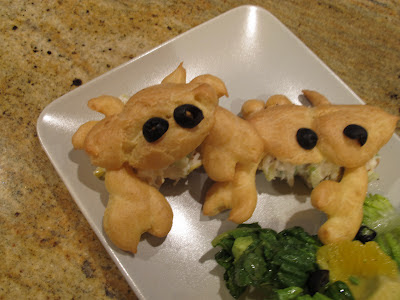Pate a choux and I are old friends. It was one of the only things I could do well at culinary school. I loved the magic that seemed to ooze from a few simple ingredients puffing up with color and taste. I made gougeres, eclairs, cream puffs...anything I could find to make with pate a choux, I would try. But, I never made swans and in recent years, I have not had much reason to make any pate a choux. So, it was a real delight to see this month's challenge.
Kat of The Bobwhites was our August 2012 Daring Baker hostess who inspired
us to have fun in creating pate a choux shapes, filled with crème patisserie or Chantilly cream. We
were encouraged to create swans or any shape we wanted and to go crazy with filling flavors
allowing our creativity to go wild!
The recipe looked sound. I remembered a few techniques that helped the pate a choux rise and dry nicely so I added those in when making the recipe. Then I got crabby....really crabby. I decided that if I could make swans, I could make crabs. so I piped a lot of crabby looking shapes in addition to swans and baked them.
I put my little crabs filled with crabmeat salad of course on the dinner plate with an orange and avocado salad. Hubby was deeeelighted.
For dessert, yes, we had swans. I made them into profiteroles filled Sweet Scoops Ginger Frozen Yogurt and perched on Coops Hot Fudge Sauce, my new obsession. The taste is rich but not overwhelming. It is better than homemade around this house.
Here is the recipe for Pate A Choux. It is a great one and easier than you may think!

Pate a Choux
(cannot be doubled)
Ingredients
½ cup (120 ml) (115 gm) (4 oz) butter 1 cup (240 ml) water ¼ teaspoon (1½ gm) salt 1 cup (240 ml) (140 gm) (5 oz) all-purpose flour 4 large eggs
Directions:
1. Line at least two baking sheets with silicone mats or parchment paper, or grease pans well.
2. Preheat oven to moderately hot 375°F/190°C/gas mark 5 .
3. In a small saucepot, combine butter, water, and salt. Heat over until butter melts, then remove from stove.
4. Add flour all at once and beat, beat, beat the mixture until the dough pulls away from the sides of the pot. I put the pot back on low heat and stir it allowing water to evaporate.
5. Add one egg, and beat until well combined. Add remaining eggs individually, beating vigorously after each addition. I use a mixer on medium low speed to add the eggs. I add them one at a tinme allowing the eggs to incorprate before adding more. Many times, I do not need to add all the eggs. I look for a consistency that is firm but loose enough to pipe through a pastry tube. Resulting mixture should be somewhat glossy, very smooth, and somewhat thick.
6. Using a ¼” (6 mm) tip on a pastry bag, pipe out about 36 swan heads. You’re aiming for something between a numeral 2 and a question mark, with a little beak if you’re skilled and/or lucky.
7. Remove the tip from the bag and pipe out 36 swan bodies. These will be about 1.5” (40 mm) long, and about 1” (25 mm) wide. One end should be a bit narrower than the other.
8. Bake the heads and bodies until golden and puffy. The heads will be done a few minutes before the bodies, so keep a close eye on the baking process.
9. Remove the pastries to a cooling rack, and let cool completely before filling.





